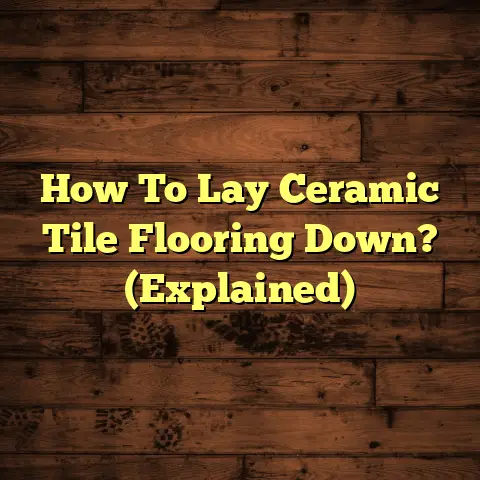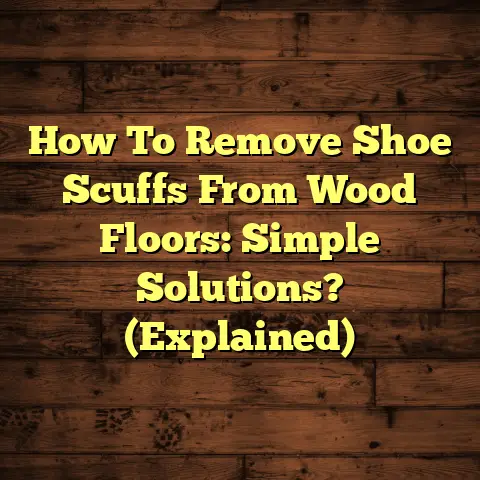Hand-Polishing Marble Floors? (1 Secret Pro Finish!)
Marble floors. Ah, the epitome of elegance! I’ve installed and restored countless marble floors over the years, and I can tell you, there’s nothing quite like the timeless beauty they bring to a home or business.
But let’s be honest, that luxurious shine doesn’t just happen. It takes work. And while professional marble restoration can be pricey, the good news is you can achieve a stunning, professional-looking finish yourself with a little elbow grease and the right know-how.
That’s where hand-polishing comes in. Don’t let the name intimidate you. It’s more accessible than you think, and I’m going to walk you through it.
I’m going to share the secret technique that really makes marble floors pop – the one pros often keep close to the vest. Ready to transform your dull, scratched marble into a gleaming masterpiece? Let’s dive in!
Section 1: Understanding Marble Floors
So, what makes marble so special? Well, it’s a metamorphic rock formed from limestone or dolomite, which is why you get those amazing, unique veining and color patterns. No two marble floors are ever exactly alike! It’s part of the charm.
But that beauty comes with some challenges. Marble is relatively soft and porous compared to, say, granite or porcelain. This means it’s susceptible to scratches, dullness, and etching.
Think about it: a dropped glass, a scuff from shoes, or even a splash of lemon juice can leave its mark. Acidic substances are marble’s worst enemy, causing those dreaded dull spots (etching).
That’s why regular maintenance is crucial. Sweeping, vacuuming (with a soft brush attachment!), and regular cleaning with a pH-neutral cleaner are essential to prevent dirt and grime from grinding into the surface and causing scratches.
I always tell my clients, prevention is better than cure. But what if your marble is already looking a little lackluster? That’s where hand-polishing comes in to restore its former glory.
Section 2: Preparing for Hand-Polishing
Alright, before we get our hands dirty, let’s gather our supplies. Here’s what you’ll need for hand-polishing your marble floors:
-
Marble Polishing Pads: These come in various grits, from coarse (for removing scratches) to fine (for polishing). I recommend a set that includes at least 400, 800, 1500, and 3000 grit pads. You can find good sets online or at specialty flooring stores.
-
Handheld Buffer/Polisher: While you can technically polish by hand (using a block), a handheld buffer will make the job much easier and give you more consistent results. Look for one with variable speed settings.
-
Marble Polishing Compound: This is a specially formulated paste or powder that helps to abrade and polish the marble surface. Make sure it’s specifically designed for marble. I usually use either a marble polishing compound or Cerium Oxide.
-
Spray Bottle: For water. We’ll need this to keep the pads and surface lubricated.
-
Microfiber Cloths: For cleaning and buffing.
-
pH-Neutral Marble Cleaner: To clean the floor before polishing.
-
Painter’s Tape: To protect baseboards and surrounding areas.
-
Gloves and Eye Protection: Safety first!
Once you’ve got your supplies, prep the workspace. Clear the area of all furniture and rugs. Thoroughly sweep or vacuum the floor to remove any loose debris. Then, clean the floor with your pH-neutral marble cleaner and let it dry completely.
Next, take a good look at your floor. Assess the damage. Are there deep scratches? Are there dull areas or etch marks? Identifying these problem spots will help you focus your efforts and choose the right polishing pads.
Section 3: The Hand-Polishing Process
Okay, time to get polishing! Here’s a step-by-step guide to the hand-polishing process:
Step 1: Cleaning the Floor
I can’t stress this enough: a clean floor is essential. Any dirt or grit left on the surface will just get ground in during polishing, causing more scratches.
Use your pH-neutral marble cleaner and a microfiber mop to thoroughly clean the entire area. Rinse well with clean water and let the floor dry completely. I usually give it at least an hour, or even overnight, to be sure.
Step 2: Assessing the Damage
Now, get down on your hands and knees (or use a bright flashlight) and inspect the floor closely. Pay attention to areas that get a lot of traffic, like doorways and walkways.
Look for scratches, dull spots, and etch marks. The severity of the damage will determine which grit of polishing pad you need to start with. If you have deep scratches, you’ll need to start with a coarser grit (like 400). For minor scratches and dullness, you can start with a finer grit (like 800).
Step 3: Choosing the Right Polishing Compound
There are many different polishing compounds on the market, and it can be confusing to choose the right one.
Generally, you’ll want to use a compound that’s specifically designed for marble. These compounds contain fine abrasives that help to polish the surface without damaging it.
Some popular options include:
-
Marble Polishing Powder: This is a fine powder that you mix with water to create a paste. It’s great for removing light scratches and restoring shine.
-
Marble Polishing Cream: This is a pre-mixed cream that’s easy to apply. It’s good for general polishing and maintenance.
-
Cerium Oxide: This is a very fine abrasive that’s often used by professionals. It’s excellent for removing stubborn scratches and etch marks, but it can be a bit more aggressive, so use it with caution.
When in doubt, ask a professional at a flooring supply store for recommendations.
Step 4: Applying Polishing Pads
Attach your chosen polishing pad to the handheld buffer. Make sure it’s securely attached.
Grit Selection:
-
400 Grit: For removing deep scratches and imperfections. Use this only if necessary.
-
800 Grit: For removing moderate scratches and preparing the surface for finer polishing.
-
1500 Grit: For polishing and refining the surface.
-
3000 Grit: For achieving a high-gloss finish.
Step 5: Polishing Technique
Now for the fun part! Here’s the key to the hand-polishing technique:
-
Wet the Pad and Surface: Lightly spray the polishing pad and the area you’re about to polish with water. This will help to lubricate the surface and prevent the pad from overheating.
-
Apply Polishing Compound: Apply a small amount of polishing compound to the area you’re polishing. A little goes a long way.
-
Start Polishing: Turn on the buffer to a low speed. Using consistent, overlapping strokes, move the buffer across the surface. Apply gentle pressure. Don’t press too hard, let the pad and compound do the work.
-
Keep it Wet: Keep the pad and surface lubricated with water. If the pad starts to dry out, it can scratch the marble.
-
Work in Sections: Work in small sections (about 2×2 feet) at a time. This will ensure that you’re polishing the entire area evenly.
-
Repeat with Finer Grits: After you’ve polished the entire area with one grit, rinse the floor thoroughly with clean water and let it dry completely. Then, repeat the process with the next finer grit of polishing pad.
-
Patience is Key: Hand-polishing takes time and effort. Don’t rush the process. The more time you spend polishing, the better the results will be.
Step 6: Buffing the Floor
After you’ve finished polishing with the finest grit pad (usually 3000), it’s time to buff the floor. This will help to remove any remaining polishing compound and bring out the shine.
Attach a clean, dry microfiber pad to the buffer. Turn on the buffer to a medium speed and buff the entire floor using consistent, overlapping strokes.
Step 7: Final Inspection
Once you’ve buffed the floor, take a final look. Check for any missed spots or areas that need additional polishing. If you find any, repeat the polishing process in those areas.
Finally, clean the floor one last time with your pH-neutral marble cleaner and a microfiber mop. Let it dry completely, and then stand back and admire your handiwork!
Section 4: The One Secret Pro Finish
Okay, now for the secret! You’ve put in the work, but this one tip will elevate your results to a truly professional level.
The secret? Diamond Paste.
I know, it sounds intimidating, but trust me, it’s not. Diamond paste is a polishing compound that contains microscopic diamond particles. These particles are incredibly effective at removing fine scratches and creating a super-smooth, high-gloss finish.
Here’s how to use it:
-
After the 3000 Grit: Once you’ve finished polishing with the 3000 grit pad, clean the floor thoroughly and let it dry.
-
Apply Diamond Paste: Apply a tiny amount of diamond paste to a clean microfiber pad. A little goes a very long way. I’m talking about a pea-sized amount for a 2×2 foot section.
-
Polish with Hand Buffer: Using the hand buffer on a low speed, gently polish the area with the diamond paste. Work in small, circular motions.
-
Don’t Overdo It: Polish for about 30-60 seconds per section. You don’t want to over-polish.
-
Buff: After polishing with the diamond paste, buff the floor with a clean, dry microfiber pad to remove any residue.
Why it Works:
Diamond paste is so effective because the diamond particles are incredibly hard and sharp. They gently abrade the surface of the marble, removing even the tiniest imperfections and creating a mirror-like finish.
Real-Life Example:
I once had a client who had tried everything to restore the shine to her marble countertops. She had used all sorts of polishing compounds and techniques, but nothing seemed to work.
I suggested she try diamond paste. She was skeptical at first, but she decided to give it a try. The results were amazing! Her countertops looked brand new.
Tips for Using Diamond Paste:
- Use Sparingly: A little goes a long way.
- Don’t Press Hard: Let the diamond particles do the work.
- Keep it Clean: Use a clean microfiber pad for each section.
- Test in an Inconspicuous Area: Before polishing the entire floor, test the diamond paste in a small, hidden area to make sure it doesn’t damage the marble.
Section 5: Maintaining the Shine
You’ve put in the effort to hand-polish your marble floors, so you want to keep them looking their best. Here are some tips for ongoing maintenance:
-
Sweep or Vacuum Regularly: Sweep or vacuum your marble floors at least once a week to remove dirt and debris. Use a soft brush attachment on your vacuum cleaner to avoid scratching the surface.
-
Clean with pH-Neutral Cleaner: Clean your marble floors with a pH-neutral marble cleaner. Avoid using acidic cleaners, such as vinegar or lemon juice, as these can etch the surface.
-
Wipe Up Spills Immediately: Wipe up spills immediately to prevent staining. Marble is porous, so spills can soak into the surface and cause discoloration.
-
Use Coasters and Placemats: Use coasters under drinks and placemats under plates to protect the marble from scratches and spills.
-
Avoid Abrasive Cleaners and Materials: Don’t use abrasive cleaners, such as steel wool or scouring pads, as these can scratch the surface.
-
Consider a Marble Sealer: Applying a marble sealer can help to protect the surface from stains and etching. Reapply the sealer every year or two, or as recommended by the manufacturer.
-
Professional Polishing: Depending on foot traffic, consider professional polishing every few years to maintain the shine and remove any accumulated scratches or etch marks.
Conclusion
Hand-polishing marble floors is a rewarding process that can transform dull, scratched surfaces into gleaming masterpieces.
With the right tools, techniques, and the secret pro finish of diamond paste, anyone can achieve beautiful, shiny marble floors.
Remember to take your time, be patient, and pay attention to detail. And don’t be afraid to experiment and find what works best for you.
So, what are you waiting for? Grab your polishing pads, your diamond paste, and get ready to unleash the hidden beauty of your marble floors! You’ll be amazed at the results. I promise.





